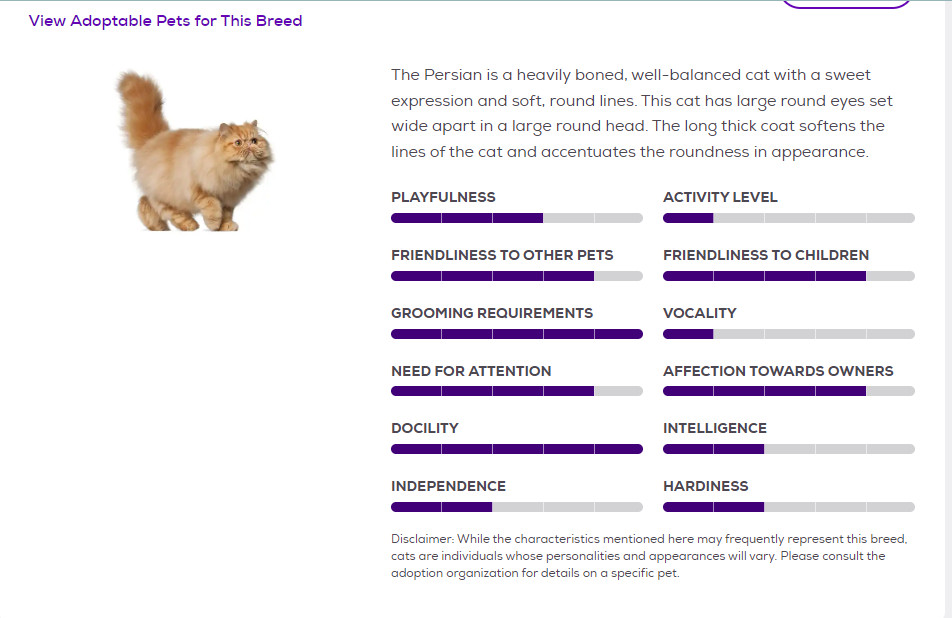Complete Information on Persian Cat Breeds, Characteristics and Health Care of Persian Cats
The Persian cat is a well-proportioned breed with a sweet facial expression, very soft lines, and a large and round face. Persian cats have large, easily recognizable eyes, set far apart on a large round head. The thick, long coat makes this species adorable and accentuates its well-rounded appearance.
In this article, we will learn about the Persian cat breed, its characteristics, and how to care for the Persian cat.
Breed profile
Called Persian cats by their country of origin, the first cats of the breed are thought to have made their way west in the 1600s in spice caravans that arrived from Iran in the early days. now. The breed was brought to Europe in the 1700s and is popular to this day, especially among cat lovers, as the Persian is one of the most popular adopted cats today. The Persian cat was first recognized by the Cat Fanciers Association (CFA) in 1871.
The Persian cat breed has a rather special appearance with a flat round face, short muzzle, and big round eyes. Persian cats come in a variety of colors, including white, black, blue, cream, and red. The Persian cat's purring personality makes it likable and comfortable, and the Persian is a sweet and loving family companion.
The Persian cat breed has a playful and gentle disposition; Their patience and friendly social nature make them great companions for households with children and other pets.
Characteristics of the Persian cat breed
The Persian cat is an average-sized 7-13 pounds cat that takes its role as a loving companion to its owners very seriously - they are always ready to be petted and fussed in seconds. slice. This beautiful kitten comes in a variety of colors and color combinations, and they get along well with all members of the family (including other furry friends). If you are ready to start grooming your Persian cat daily. Surely you will not find a more lovely companion.
Persians are fun and curious cats, but they won't drive you crazy rummaging around the house looking for spilled cups of water. In addition, the Persian cat has a strong body, so it is difficult to try to climb the curtains. Chances are you'll find them napping on the most comfortable mattress they can find.
“Every cat is an individual, which means that each cat may not exhibit a Persian temperament,” says Marilyn Krieger, a certified cat behavior consultant in San Francisco. "In general, Persians are known to be quiet, social, and affectionate cats that love to be around their people, wanting to be petted and cuddled."
To keep the Persian cat's luxurious coat in tip-top shape, it needs daily brushing to avoid tangles and tangles. Brushing and combing will also remove excess dirt, dead hair, and even cat litter that may have gotten into their fur. Bathing is essential to keeping the Persian cat's coat and skin in top condition. If you start bathing your cats when they are still kittens, they won't hesitate to put them in a warm bath as adults. If you adopt an adult Persian, they may not be ready to bathe, so you may need to resort to spot cleaning with a warm, damp cloth.
Because the Persian cat has a sweet personality, it is a great pet for all family members, especially the elderly and young children. If there's a comfortable ring around, your Quartet will find it. As a general rule, Persian cats also get along very well with dogs and other cats.
In addition to regular brushing, keep in mind that Persian cats have a number of other care requirements to keep them healthy and happy. The typical lifespan of the Persian cat breed is 10-15 years. Like any other breed of cat, Persians are prone to a number of health problems, and they have a number of potentially genetic health issues that potential owners need to be aware of.
The typical lifespan of the Persian cat breed is 10-15 years. Like any other breed of cat, Persians are prone to a number of health problems, and they have a number of potentially genetic health issues that potential owners need to be aware of.
Two common diseases in Persian cats include progressive retinal atrophy (PRA) and polycystic kidney disease (PKD). PKD is an inherited disorder that causes small fluid-filled sacs in kidney tissue to grow and multiply over time, eventually leading to kidney failure. PRA is an inherited feline eye disease in which retinal cells degenerate over time and eventually lead to blindness.
According to the American Animal Hospital Association, eye and tooth problems are also a problem for Persian cats, especially those with flatter faces and short jaws. Regular attention to these areas will help your Persian cat stay in better health.
And like other cat breeds, Persians should be spayed and neutered, and never allowed to go outside without close supervision from their owners.




.webp)

No comments:
New comments are not allowed.